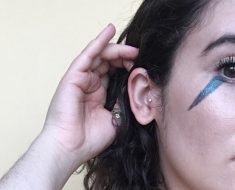These days, it sometimes feels as if eczema is just as ubiquitous as acne. (For the record, it's not: An estimated 60 million Americans have active acne, while eczema affects an estimated 32 million people). Regardless, it's a very common condition that, akin to acne, can impact people's lives both physically and emotionally. Despite being so widespread, though, there's still so much we don't know about the condition. For instance, many people are unaware that eczema is actually an umbrella term — as is dermatitis — used to describe a gamut of skin inflammations. They are commonly confused and thought of as two totally different afflictions.
To set the record straight once and for all, we tapped a few trusted dermatologists to get the facts. Keep scrolling for answers.
So eczema and dermatitis are the same?
More or less. The two conditions are often used interchangeably by dermatologists when speaking about a variety of skin rashes and irritations. "Eczema and dermatitis are generic terms used to indiscriminately describe many types of skin inflammation," says New York City-based dermatologist Neil Sadick, who adds that the most common types we encounter are contact, seborrheic, and atopic dermatitis. "Often, atopic dermatitis is considered a severe form of eczema," says Sadick. According to Sejal Shah, dermatologist and founder of Smarter Skin Dermatology, most people don't realize that both terms are generic (similar to alopecia), but that the specific types can have different causes and locations.
How can you differentiate the two?
Sure, eczema and dermatitis refer to the same types of skin conditions, but just like with the different forms of acne, there are discrepancies among them. "Different types of dermatitis have different causes and appear in different locations of the body," says Sadick. "For example, atopic dermatitis is a chronic condition that begins at infancy, which usually affects the elbows, knees, and neck, and is caused by a combination of genetic and environmental factors."
On the other hand, Sadick says contact dermatitis is spurred by direct exposure to a particular allergen or irritant, like poison ivy, nickel, or perfumes. And as for seborrheic dermatitis, Sadick says it generally affects areas of the body that produce more oil, such as the face, upper chest, and back, and can also be triggered by yeast. All this to say: Despite these distinctions, each condition technically falls under the umbrella of eczema, but can also be called dermatitis, too.
Do you treat them the same way?
Because the symptoms are virtually the same, they're also treated fairly similarly, says New York City-based dermatologist Joshua Zeichner. "[We use things like] gentle skin cleansers that don't disrupt the skin barrier and enhance skin hydration, as well as moisturizers that provide a protective seal over the skin to enhance skin hydration," he says. "Topical cortisone creams also help reduce inflammation."
Sadick adds that contact dermatitis is usually managed by avoiding the trigger cause and short-term treatments like cortisone. What's more: Seborrheic dermatitis can benefit from topical antifungal creams or medicated shampoos, according to Sadick.
Needless to say, if you're struggling with inflamed or rashy skin that seems like it could be attributed to dermatitis/eczema, make an appointment with your doctor ASAP to determine the cause, type, and treatment plan.
Source: Read Full Article





